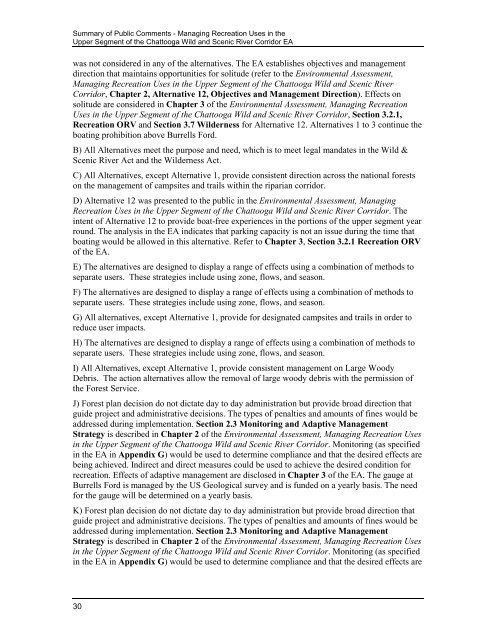Resource Name (Heading 1) - USDA Forest Service - US ...
Resource Name (Heading 1) - USDA Forest Service - US ...
Resource Name (Heading 1) - USDA Forest Service - US ...
Create successful ePaper yourself
Turn your PDF publications into a flip-book with our unique Google optimized e-Paper software.
Summary of Public Comments - Managing Recreation Uses in the<br />
Upper Segment of the Chattooga Wild and Scenic River Corridor EA<br />
was not considered in any of the alternatives. The EA establishes objectives and management<br />
direction that maintains opportunities for solitude (refer to the Environmental Assessment,<br />
Managing Recreation Uses in the Upper Segment of the Chattooga Wild and Scenic River<br />
Corridor, Chapter 2, Alternative 12, Objectives and Management Direction). Effects on<br />
solitude are considered in Chapter 3 of the Environmental Assessment, Managing Recreation<br />
Uses in the Upper Segment of the Chattooga Wild and Scenic River Corridor, Section 3.2.1,<br />
Recreation ORV and Section 3.7 Wilderness for Alternative 12. Alternatives 1 to 3 continue the<br />
boating prohibition above Burrells Ford.<br />
B) All Alternatives meet the purpose and need, which is to meet legal mandates in the Wild &<br />
Scenic River Act and the Wilderness Act.<br />
C) All Alternatives, except Alternative 1, provide consistent direction across the national forests<br />
on the management of campsites and trails within the riparian corridor.<br />
D) Alternative 12 was presented to the public in the Environmental Assessment, Managing<br />
Recreation Uses in the Upper Segment of the Chattooga Wild and Scenic River Corridor. The<br />
intent of Alternative 12 to provide boat-free experiences in the portions of the upper segment year<br />
round. The analysis in the EA indicates that parking capacity is not an issue during the time that<br />
boating would be allowed in this alternative. Refer to Chapter 3, Section 3.2.1 Recreation ORV<br />
of the EA.<br />
E) The alternatives are designed to display a range of effects using a combination of methods to<br />
separate users. These strategies include using zone, flows, and season.<br />
F) The alternatives are designed to display a range of effects using a combination of methods to<br />
separate users. These strategies include using zone, flows, and season.<br />
G) All alternatives, except Alternative 1, provide for designated campsites and trails in order to<br />
reduce user impacts.<br />
H) The alternatives are designed to display a range of effects using a combination of methods to<br />
separate users. These strategies include using zone, flows, and season.<br />
I) All Alternatives, except Alternative 1, provide consistent management on Large Woody<br />
Debris. The action alternatives allow the removal of large woody debris with the permission of<br />
the <strong>Forest</strong> <strong>Service</strong>.<br />
J) <strong>Forest</strong> plan decision do not dictate day to day administration but provide broad direction that<br />
guide project and administrative decisions. The types of penalties and amounts of fines would be<br />
addressed during implementation. Section 2.3 Monitoring and Adaptive Management<br />
Strategy is described in Chapter 2 of the Environmental Assessment, Managing Recreation Uses<br />
in the Upper Segment of the Chattooga Wild and Scenic River Corridor. Monitoring (as specified<br />
in the EA in Appendix G) would be used to determine compliance and that the desired effects are<br />
being achieved. Indirect and direct measures could be used to achieve the desired condition for<br />
recreation. Effects of adaptive management are disclosed in Chapter 3 of the EA. The gauge at<br />
Burrells Ford is managed by the <strong>US</strong> Geological survey and is funded on a yearly basis. The need<br />
for the gauge will be determined on a yearly basis.<br />
K) <strong>Forest</strong> plan decision do not dictate day to day administration but provide broad direction that<br />
guide project and administrative decisions. The types of penalties and amounts of fines would be<br />
addressed during implementation. Section 2.3 Monitoring and Adaptive Management<br />
Strategy is described in Chapter 2 of the Environmental Assessment, Managing Recreation Uses<br />
in the Upper Segment of the Chattooga Wild and Scenic River Corridor. Monitoring (as specified<br />
in the EA in Appendix G) would be used to determine compliance and that the desired effects are<br />
30
















